| Investigación Básica | https://doi.org/10.21041/ra.v12i2.595 |
Modifications of the rupture envelope in clayey soils with different volumetric stabilizer
Modificações do envelope de ruptura em solos argilosos com diferentes estabilizadores volumétricos Modificaciones de la envolvente de falla en suelos arcillosos con distintos estabilizadores volumétrico
Adrià
Sánchez Calvillo1
![]() ,
Elia Mercedes
Alonso Gúzman1
2
*
,
Elia Mercedes
Alonso Gúzman1
2
*
![]() ,
Wilfrido
Martínez2
,
Wilfrido
Martínez2
![]() ,
Hugo Luis Chávez
García2
,
Hugo Luis Chávez
García2
![]() ,
Marco Antonio
Navarrete Serás2
,
Marco Antonio
Navarrete Serás2
![]() ,
Mauricio
Arreola Sanchez2
,
Mauricio
Arreola Sanchez2
![]() ,
Jorge Alberto
Borrego Perez2
,
Jorge Alberto
Borrego Perez2
![]() ,
Luisa
Equihua-Anguiano2
,
Luisa
Equihua-Anguiano2
![]() ,
Ernesto Alberto
Núñez2
,
Ernesto Alberto
Núñez2
![]() ,
O.
Miranda2
,
O.
Miranda2
![]()
1 Faculty of Architecture, Universidad Michoacana San Nicolás de Hidalgo, Morelia, Mexico.
2 Materials Department, Faculty of Civil Engineering, Universidad Michoacana San Nicolás de Hidalgo, Morelia, Mexico.
*Contact author: elia.alonso@umich.mx
Reception:
March
01,
2022.
Acceptance:
April
19,
2022.
Publication: May 01, 2022.
| Cite as: Sánchez,A., Alonso,E.,Martínez,W.,Chávez,H.,Navarrete,M., Arreola,M., Borrego,J., Equihua, L., Núñez, E., Miranda, O. (2022), “Modifications of the rupture envelope in clayey soils with different volumetric stabilizer”, Revista ALCONPAT, 12 (2), pp. 227 – 247, DOI: https://doi.org/10.21041/ra.v12i2.595 |
Abstract
The modifications of seven different stabilizers (lime, cement, nopal fibers, river sand, volcanic sand, sodium sulphate and gypsum) on a clayey soil of Santiago Undameo, in Michoacan, Mexico, were analyzed to observe the changes in the properties and the rupture envelope. Sieve analysis, hydraulic sedimentation, index properties, compressive strength and Proctor were performed to the natural soil; while the variation of the index properties and the rupture envelope were determined for the stabilized mixtures. The additions improved the behavior of the high plasticity soil, diminishing the volumetric deformations and increasing the mechanical resistance, shear strength and angle of internal friction. This research contributes positively to the restoration of earthen heritage buildings, civil works, construction pathologies and construction technologies. The research was performed in the laboratory under international standards.
Keywords:
soil stabilization,
mechanical properties,
shear strength,
cohesion,
angle of internal friction,
restoration
1. Introduction
Clayey soils, commonly known as clays, are employed for many applications, including the use as construction materials, being essential elements for our society since the first stages of civilization till our modern era. Different construction elements and components, like adobes, have been found in distinct cultures and places; with examples of exceptional antiquity in both the American and the European continents (Mauricio, et al., 2021). We can find important examples of the use of clayey soils: as impermeable elements in the core of the dams and water bodies for agricultural and irrigation purposes, production of Portland cement, building of land routes and roadways, to manufacture ceramic elements and components, for the vernacular and earthen architecture, to restore historical and heritage constructions, artificial wetlands, water cleaning and treatment, among many others.
Due to the easy availability and abundance of material in many regions of the world, clayey soils have an excellent appreciation because of their sustainable properties and the low energetic and environmental impact that they produce (Costa et. al., 2019). Clays are by definition mineral sediments constituted mainly by hydrous aluminium phyllosilicates with a fine and divided particle size. Additionally, clays have excellent binding properties, so they have been used historically as cementitious materials (Sanchez-Calvillo, et al., 2021).
In Mexico, we can find different types of clays, and they have been used for construction purposes over time; particularly, in the State of Michoacan, we can find the presence of clays in construction components like adobes, ceramic bricks, union mortars and earthen refurbishments, among many others. Santiago Undameo, a locality positioned in the northeast of the State of Michoacan has one of the most important clay quarries of the region, due to the proximity to the capital of the state, Morelia (See Figure 1). The Historic Centre of Morelia, a UNESCO World Heritage Site, has more than 1000 heritage buildings and monuments, all of them built with traditional and colonial construction techniques, with a widespread use of clayey soil and other local materials of the region.
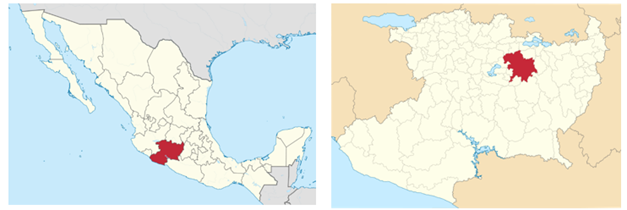 |
||||
| Figure 1. (a) Location of Michoacan within Mexico; (b) Location of the municipality of Morelia, including Santiago Undameo, within the State of Michoacan | ||||
The soils taken from this locality have an important proportion of clay minerals, which have high plasticity properties that generate instability and relevant volumetric deformations in contact with water; this situation causes pathologies in the buildings and the civil engineering constructions. Historically, a great variety of materials has been employed as stabilizers of the clays, to diminish the high hygroscopic plasticity presented and consequently reducing the lineal and volumetric contractions in presence of water (Daneels et al., 2020). This stabilization is essential for the earthen construction and architecture areas, and the bases and subbases of flexible paving; the stabilizations help to enhance the durability of these structures while improves the mechanical resistances (Laborel-Préneron et al., 2021), being all these properties very well appreciated in the construction field.
The research interest lies in the complexity of the studied soils in Santiago Undameo, since historically they have presented high plasticity and consequently great volumetric deformations, which have big affectation on the stability of the existing constructions of the studied region.
On the other hand, the earthen architecture in the state of Michoacan, despite its wealth, variety and cultural importance, has been relegated and abandoned, therefore it is essential to do more research works about this sustainable resource with easy access for the communities. Besides, to understand the behaviour of these clayey soils in combination with different stabilizers, will help to improve the actions of intervention, restoration and understanding of the existing pathologies.
There are plenty of materials used as stabilizers for construction purposes, many of them with a background of scientific research: lime (Taallah y Guettala, 2016; Navarro Mendoza et. al., 2019), portland cement (Dao et al., 2018; Jitha et. al., 2020), nopal fibres (Ige y Danso, 2020; Li Piani, 2020), rivers sand, volcanic sand, sodium sulphate and gypsum (hemihydrate calcium sulphate) (Martínez, et al., 2018).
The stabilizations with cement, lime and alkaline solutions are the most usual at global level (Abhilash, et al., 2022), furthermore, other research works have explored the use of sugarcane bagasse ashes as an alternative to improve the behaviour of soils in their physical properties like confinement, densification and volumetric stability; and the chemical properties from the reactions of the stabilizer agent (cement or lime) with water (Moraes et al., 2015; Ojeda Farías et al., 2018).
We can find and extensive bibliography about the utilization of fibres and vegetative materials, mainly to avoid the shrinkage and cracking of compact construction elements, like the adobes, helping to increase their mechanical capacities (Yetgin, et al., 2008); multiple relevant research works achieved to improve the properties of these masonries (Sharma, et al., 2015; Araya-Letelier, et al., 2021). However, the modern development of upgraded earthen construction techniques, like the CEB (Compressed Earth Block) has allowed to search for new solutions including fibres with diverse origin in combination with other stabilizers like PC or L (Nagaraj, et al., 2014; Taallah y Guettala, 2016; Navarro Mendoza, et al., 2019).
In Mexico, the use of products derived from the opuntia ficus indica, commonly known as nopal, is very common for construction purposes, both in mucilage and fibres presentation. One of the most usual ways to use the mucilage is to boil the cacti plant and adding the liquid obtained to the construction mortar mixtures, being a solution recommended by the heritage regulatory institutions to restore historical buildings and monuments. With this methodology there have been proved increases in the mechanical resistance and the workability of the mortars (Martínez et al., 2008). In addition, correlation studies with other additions and stabilizers of historical use have shown an even better mechanical behaviour with the addition of this mucilage (Alonso et al., 2002).
In this research, seven stabilizer materials were employed to improve the behaviour of a clayey soil from Santiago Undameo as a control sample (CS). The stabilizers were: lime (L), Portland cement (PC), dehydrated pulverized fibres of cactus opuntia ficus indica (NF), river sand (RS), volcanic sand (VS), sodium sulphate (SS), and gypsum (hemihydrate calcium sulphate) (G). To measure the changes generated on the studied soil, there were performed unconsolidated undrained triaxial shear tests (UU), hydraulic classifier test, sieve analysis, the Standard Proctor test for both the CS and the stabilized mixtures. The analyses of the samples will provide significant information which helps to improve the earthen architecture and the construction systems which use clays as construction materials, both for modern construction works and conservation of architectural heritage.
2. Materials and methods
The soil samples of this research were obtained from the clay quarry of Santiago Undameo, a locality near Morelia, the capital of the State of Michoacan, in Mexico. The quarry is located within the coordinates 19°42' latitude North and 101°11.4' longitude West, near the shore of the Cointzio dam (See Figure 2), where local people produce adobes and handmade ceramic bricks (See Figure 3), which generate the rural dwellings of the near communities. After the sampling of the materials and taking the specimens, they were brought to the materials laboratory “Ing. Luis Silva Ruelas” of the Faculty of Civil Engineering of the UMSNH, where the experimentation was performed.
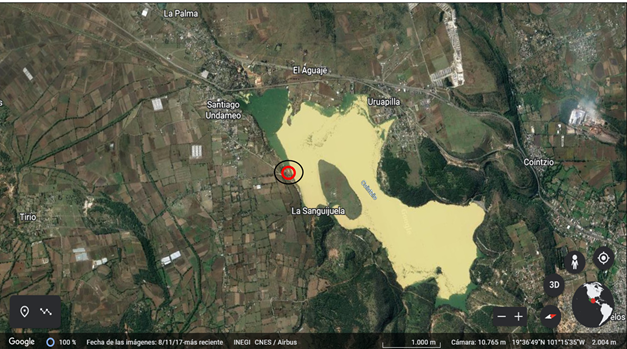 |
||||
| Figure 2. Location of the material quarry in Santiago Undameo (Source: Google Earth, 2022). | ||||
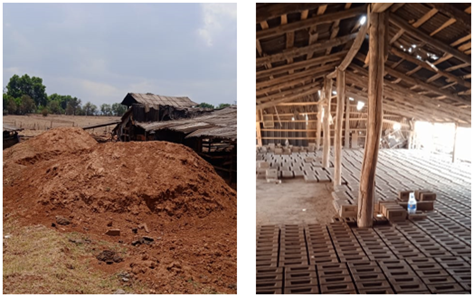 |
||||
| Figure 3. (a) Quarry with clayey soils in Santiago Undameo; (b) Manufacturing of ceramic and earthen construction components. | ||||
All the trials proposed in this document were executed in triplicate. The tests were fulfilled first with the control samples of the original soil, and later with the mixtures of clays and different stabilizers. Table 1 shows the stabilizers employed for this research, as well as the percentage by weight utilized for the mixtures.
Regarding the coarse material, the RS was provided from the quarry “El Cuervo” in the locality of Huajumbaro, Mexico, with coordinates: longitude 100.742500 degrees, latitude 19.403333 degrees and 1800 masl; this material is a silicic aggregate with round morphology. On the other hand, the VS was extracted from the quarry “Joyitas”, also located in Michoacan, Mexico, with coordinates: longitude 101.380000 degrees, latitude 19.730000 degrees and 2082 masl; this aggregate is an andesite with irregular morphology.
It is important to note that in previous research works each one of the stabilizers was tested and scanned in percentages of 1, 2, 3, 4, 5, 6, 7, 8, 9 and 10 % by weight of the soil (Flores Rentería, 2010), to assess the optimum content for each one of them. The better results for each stabilizer are shown in Table 1.
| Table 1. Percentages of the stabilizers by weight. | ||||||||||||||
| Stabilizers | % Stabilizer | |||||||||||||
|---|---|---|---|---|---|---|---|---|---|---|---|---|---|---|
| L | 3.0 | |||||||||||||
| PC | 3.0 | |||||||||||||
| NF | 0.5 | |||||||||||||
| RS | 10.0 | |||||||||||||
| VS | 10.0 | |||||||||||||
| SS | 0.5 | |||||||||||||
| G | 6.0 | |||||||||||||
For this research there were performed many tests and trials to characterize the clayey soils, which are shown in Table 2. All the experimentation was fulfilled in the laboratory “Ing. Luis Silva Ruelas” from the Faculty of Civil Engineering, UMSNH.
| Table 2. Testing and standards followed in the present research. | ||||||||||||||
| Test | Standard | |||||||||||||
|---|---|---|---|---|---|---|---|---|---|---|---|---|---|---|
| Atterberg limits and Unified Soil Classification System USCS | ASTM D2487-17 | |||||||||||||
| ASTM D4318-17 | ||||||||||||||
| Mechanical analysis of soils | ASTM C136/C136M-19 | |||||||||||||
| Hydraulic classifier | ASTM D7928-17 | |||||||||||||
| Unconsolidated undrained (UU) triaxial test | ASTM D2850-15 | |||||||||||||
| UNE-EN ISO 17892-8:2019 | ||||||||||||||
| Proctor standard test variant A | ASTM D698-12 | |||||||||||||
| Particle size < mesh nº 200 | ASTM D421-85(2007) W2016 | |||||||||||||
| Particle size > mesh nº 200 | ASTM D 422-63(2007) W2016 | |||||||||||||
The UU triaxial compression test was performed with three different confinements (σ) for each one of the samples studied, as it can be spotted in Table 3. Once the specimens failed, they were left in the oven for 24 hours at 105 +/-5 ºC to obtain the humidity parameter according the standards.
| Table 3. UU triaxial test and confinement strength applied. | ||||||||||||||
| Sample | Confinement strength (kgf/cm2) | |||||||||||||
|---|---|---|---|---|---|---|---|---|---|---|---|---|---|---|
| 1 | σ3= 0.3 | |||||||||||||
| 2 | σ3= 0.6 | |||||||||||||
| 3 | σ3= 0.9 | |||||||||||||
The particle size distribution of the control sample (CS), for the material retained by the mesh ASTM nº 200 was performed following the ASTM D421-85 (2007) W2016; while the material which passed through the ASTM nº 200 mesh was analysed with the hydraulic sedimentation apparatus, with an approximate length time of one week to take regular readings according to the ASTM D 422-63 (2007) W2016 standard. To classify the samples of the clayey soil the USCS system was followed with the ASTM D-2487-17 standard, being the most extended procedure in geotechnical practice.
The shearing resistance was obtained by the Mohr-Coulomb failure criterion, a theory constituted in 1773 which allows to determine the cohesion (c) and the internal friction angle (().
On the other hand, to obtain the reconstituted specimens for the UU triaxial tests, the stabilizers were added to the natural soil, homogenizing and matching the reconstitution by means of the maximum specific gravity ((dmáx) and the optimum water content ((ópt), obtained with the Standardized Proctor test (variant A). The optimum water content ((ópt) is the content of water accomplished with the greater accommodation of the particles and the minimum void ratio (emín); while the great volumetric weight of the dry material, for a determined level of compaction is designated as the maximum specific gravity ((dmáx).
The activity index (A) of the clays was obtained with the hydrometer test (ASTM D 422-63, 2016), by means of the equation (1). Figure 4 shows the variation of A as a function of different clay minerals.
Where:
A= Activity of the clay
PI = Plasticity Index
3. Results and discussion
In this research, the modification of the rupture envelope of clayey soils with different volumetric stabilizers was studied. Therefore, in the next section the results obtained will be analysed and discussed, first considering the results of the tests performed on the natural reconstituted soil acting as a control sample (CS); and subsequently correlating the results of the stabilized mixtures with the seven different additions.
3.1 Analyses of the samples from the original soil
The results of the index properties are shown in Table 4, including humidity ((), LL, PL, PI, LC and VC respectively.
The Figure 2 shows both the results obtained from the sieve analysis, performed with ASTM meshes; and the fine material particle size, which was performed with the hydrometer analysis. The A of the clay was obtained with the last test.
The results of the particle size analysis showed that the 82% of the soil material went through the ASTM nº 200 mesh, classifying it as a fine soil. Also, the values of LL and PI locate the material within CH zone (See Figure 6). The hydrometer analysis was performed to obtain the fine particle size and determine the A of the clays. In Figure 4 we can see how the percentage of material going through 2(m size is about 40%, which indicates a significant proportion of micrometric material in the clayey soils of Santiago Undameo.
From the PI obtained, 32.7%, there was calculated an A of 0.81 (See Equation 1). According to Skempton (1953) the corresponding clay mineral is an illite (See Figure 4), which presents a much lower A than montmorillonites for instance. Nevertheless, illites have some drawbacks for construction due to their tendency to collapse and because they suffer great volumetric changes in presence of water, being problematic for civil engineering structures (Mirjalili et. al., 2020).
3.2 Analyses of the mixtures of clayey soils with different stabilizers
To classify the clayey material (the percentage of material which passes through the ASTM mesh nº 200) with different stabilizers, the technical personal of the laboratory performed the Atterberg limits trial. The results of the test are displayed in the plasticity chart (See Figure 6) where the position of the natural soil and the mixtures reflect their classification according the USCS. The natural soil from Santiago Undameo is classified as a CH, which matches the results of the A presented by the material. All the mixtures can be found in the CL zone, being evidence of the change of properties provided by the stabilizers; nevertheless, the mixture with NF is located in the limit between high plasticity and low plasticity, which means that it wouldn’t be the best solution for some construction or restoration purposes. On the other hand, the combination with 0.5% SS was classified as CL (See Figure 6), presenting the greater reduction of the LL from 55.2% to 40.2% (See Table 5).
In the case of non-heritage stabilized clays (because it is easier to obtain more quantifications than patrimonial samples), it is possible to find correlation equations (Parisi et al., 2020; Vasic et al., 2020) with the results of the different physicomechanical tests (Olacia et al., 2020; Rodríguez et al., 2018; Lan et al., 2020). The correlation equations allow to estimate some parameters, to either validate mathematical models or to find math relations between variables with statistically acceptable correlation coefficients. These correlations are useful to estimate parameters in engineering projects which include the use of clayey soils. Some researchers have found and proposed correlation equations with the variables of soils for practical purposes (Akkaya, Özvan, y Özvan, 2019; Chompoorat et al., 2022; Wang et al., 2021; Wu et. al., 2022).
Figure 7 reveals the ensemble of index properties of each one of the stabilized mixtures and the natural soil. From the graph, it is noted that the stabilizers diminish the optimum water content (ω), the LL and the PI; on the other hand, the stabilizers also produce an irregular behaviour of the PL, LC and VC, which could be caused by the particular properties of each one of the stabilizers. For these three index properties (PL, LC and VC) the results obtained were both superior and inferior than the natural soil used as a control sample.
The Standard Proctor test determines the necessary content of water ((ópt) to reach the maximum specific gravity ((dmáx) trough mechanical compaction (See Figure 8). In this case, it can be clearly noted the effect of the stabilizers on the necessary water content and the increase or decrease of the maximum specific gravity. The Figure 8 shows both, the behaviour of the CS and the stabilized mixtures with different colours, with the greater results corresponding to the RS and the lowers to L. The optimum water contents to achieve the maximum specific gravity are shown in Figure 9.
Figure 9 displays the results of the Standard Proctor test (Variant A), allowing to perceive the effect of the different stabilizers regarding the maximum specific gravity ((dmáx) and the optimum water content ((opt) through the compaction of the samples in the laboratory. Reading the graph, we can observe the clear reduction of the optimum water content with the addition of L, PC and NF; this decrease also involves a related reduction of the specific gravity, which could be caused by the workability and plasticity properties of these materials, keeping in mind that water acts as a lubricant for the accommodation of the clay particles. Both L and PC are known to maintain a fluidity degree for certain time to provide facility of application during construction works; also, this behaviour has been monitored for lime and cement mortars which incorporate NF (Díaz-Blanco, et al., 2019; Knapen y Van Gemert, 2009; Ramírez-Arellanes et al., 2012).
Regarding the coarse materials, it is clear that they do not change their physical properties in presence of water, therefore they not change or inflict on the (opt; nevertheless, they do decrease the (dmáx of the natural soil, which can be attributed to the particle size, porosity and density, as they occupy more volume than the original sample of soil. The SS can behave to some extent as lithic material if the water is aggregated at room temperature, and the dissolution of the sample can be slower than the time necessary to perform the test.
Figure 9 also reveals small changes in the (dmax parameter (Miranda, 2017), while the main differences between the stabilizers can be noted in the optimal water content (opt. The water content is also necessary to later obtain the emín parameter.
3.3 Unconsolidated Undrained triaxial test (UU)
To perform the UU triaxial tests there were used reconstituted specimens, for the eight cases considering the natural soil and the seven stabilizers. For the fulfilment of the trial a total of 144 specimens were tested (See Figure 10).
In Figure 11 we can see the correlation between the Deviator Stress ((d) and the Unitary Strain ((), data that indicates us the failure mode of every combination of the clayey soil and stabilizers. The samples which presented an improvement in the plasticity (CL) also presented changes in their expansibility behaviour. This behaviour of the mixtures is really meaningful, as it can improve these materials and impact positively on construction purposes, being clever implementations on field work and many other applications.
Practically all the mixtures improved their behaviour regarding the compression strength and strains. It is clear that the 6% G mixture enhances the material rigidizing it, and increasing the mechanical compression resistance, which is noted in the greater grade of its curve.
The stabilization of soils with gypsum is not very common in practical purposes and the information about its use is scarce; nevertheless, the results shown provide certainty about its utilization. It is known that the G is soluble in water, for this reason thorough protective measures are required. After the G samples we can find the mixtures with L, RS and PC with similar behaviours; these materials are very usual for the stabilization of soils, therefore the improvement was expected. For instance, the mixtures with L produce a reaction between the lime and the water which diminish the permeability of the soil and increase the loading capacity in few hours, building a structural layer strong and flexible (Reginaldo et al., 2018).
Figure 12 displays an example of rupture envelope, using at least 3 Mohr’s circles to determine the tendency of the envelope line, and with it, calculate the cohesion (c) and the internal friction angle (φ).
In order to simplify the display and graphic representation of the rupture envelopes, the Figure 13 presents the set of results of the CS and the stabilized clayey soils without showing the 3 respective Mohr’s circles which produced the envelope.
In Figure 14 it can be spotted how all the stabilizers employed increase the cohesion to a greater or lesser extent. The variation on the improvement degree of the cohesion (c) depends on the particular properties of each stabilizer regarding the prime materials and the natural clayey soil. In this trial the most outstanding materials were RS, VS, SS and G. Regarding the internal friction angle (φ), it can be observed that the performance is inversely proportional to the cohesion: the better results correspond to L, PC and G; these three stabilizers are materials which react chemically in presence of water and form new mineral phases with more mechanical resistance, which has a positive impact on the ( value. It is very interesting the fact that G impacts positively on both variables, being the only stabilizer with this behaviour.
It is important to mention that the increase of the internal friction angle is more important than the increase of cohesion, being a property highly appreciated in soils for building purposes. This is because the improve in the mechanical resistance can be easily lost with the presence and contact of water next to the soil particles, therefore, the capability of resistance become more important due to the cohesion between the clay particles.
4. Conclusions
The results shown in this manuscript correspond only to the study of the clayey soils of Santiago Undameo, in Michoacan, Mexico. It is important to underline that the extrapolation of these results to similar materials must be cautious and rely on the direct experimentation. The methodology proposed in this research and the innovation degree of some tests for clayey soils can be extremely useful for many applications in construction materials and for the restoration of heritage and historical buildings.
The rupture envelopes lines obtained with the control simple (the natural soil without any stabilization) allowed to determine the change on the maximum stress withstander, by means of the cohesion (c) and the angle of internal friction (φ) parameters. These two were obtained for each one of the stabilizers used, being the main contribution of the research.
Regarding the benefits of the stabilization, while improving the behaviour of soils we are impacting positively the environment, due to the several ecological and economic benefits we can achieve. For example, we can reduce or eliminate the transportation costs of the materials employed in a construction, which increase with the distance to the exploitation site. On the other hand, with the stabilization, we can achieve those certain materials which don’t meet the standard requirements (a common situation with the materials extracted on site), reach the necessary resistance for their performance as pavement structures for instance. Regarding these civil engineering uses we can improve the behaviour of the soils, while reducing the thickness of the structures, which will decrease substantively the budget of the road paving works and a lesser operation of the quarries.
The results shown that six of the stabilizers added to the clayey soils modified the USCS classification, from CH to CL. The 3% L sample showed the best improvement, since the mixture located between the region of the silts and the low plasticity clays in the chart. On the other hand, the NF addition modified next to nothing the properties of the clay, being located in the limit between high and low plasticity materials. The additions provide many other changes in the properties of soils, nevertheless, the plasticity is one of the most important due to the problems explained in the introduction of the article presented by the earthen constructions, the infrastructures or the heritage buildings and monuments.
With the rupture envelopes, it was observed a change of the cohesion c and the internal friction angle (, which translates into an increase of the mechanical resistance of the mixtures. In this respect, the stabilizers which produced a higher friction between the soil particles (greater () were G, L, PC, RS and NF respectively. Conversely, VS did not provide any increase in the mechanical properties, as the internal friction angle (( ) was very similar to the natural soil; additionally, the SS was not very successful for this purpose.
The addition of certain stabilizers guarantees a meaningful increase of the mechanical properties of expansive soils. In the case of Santiago Undameo, the addition of L and G provided an improvement of the physical and mechanical properties. These two materials diminish the plasticity while enhancing the workability of the construction systems, being very desirable qualities for building and restoration purposes, with minimal aesthetic and colorimetric changes. Both L and G require lesser production energy than other industrial stabilizers, therefore they generate a minor environmental impact, being sustainable materials.
In the case of the adobes of the vernacular Mexican heritage and its restoration, these structures have several conservation problems and also difficulties for the stabilization of the materials. For these traditional systems, L continues to be the best choice for the stabilization of clays, in contrast with the PC, which is not suitable for these uses. Nevertheless, the PC has demonstrated utility for many other uses regarding soils, for example the manufacturing of CEB, a construction technology with low environmental impact which can achieve remarkable mechanical resistances and also presents a better behaviour in presence of water due to its compaction process.
Finally, we can conclude that the seven proposed additions, being analysed in laboratory under the international standards ASTM, improved the behaviour of a high plasticity soil. The stabilizers diminished the volumetric and lineal deformations and increased the mechanical resistance and the angle of internal friction of the mixtures. This research contributes beneficially to the improvement of clayey soils for purposes like the restoration of earthen heritage constructions, civil engineering, pathologies in buildings and construction technologies.
5. Acknowledgements
The authors thank the financial support given by the Coordinación de la Investigación Científica and the materials laboratory “Ing. Luis Silva Ruelas” of the Faculty of Civil Engineering of the UMSNH; the CONACYT through the project PRONACES 321260; and the Program Programa de Becas Nacionales; the SEP (Secretaría de Educación Pública) with the programs Prodep/Promep. The authors also acknowledge the inestimable technical support of the engineers O. S. Miranda Leal, F. J. Jerónimo Rodríguez, J. I. Bocanegra Torres, and P. García Díaz during the mechanical quantifications, as well as the technicians of the laboratory LANCIC-UNAM during the micro-characterization of the materials.
References
Abhilash, H. N., Hamard, E., Beckett, C. T., Morel, J.-C., Varum, H., Silveira, D., Ilampas, R. (2022), Chapter 4. Mechanical Behaviour of Earth Building Materials. In A. Fabbri, J.-C. Morel, J.-E. Aubert, Q.-B. Bui, D. Gallipoli, B. V. Venkatarama Reddy (Eds.), “Testing and Characterisation of Earth-based Building Materials”, Springer, cap. 4, pp. 127-180. doi: https://doi.org/10.1007/978-3-030-83297-1_4
Akkaya, İ., Özvan, A., Özvan, E. E. (2019), A new empirical correlation between pressuremeter modules (EM) and shear wave velocity (Vs) for clay soils. Journal of Applied Geophysics. 171(103865). https://doi.org/10.1016/j.jappgeo.2019.103865
Alonso, E., Martinez-Gomez, L., Martinez, W., & Castano, V. M. (2002), Preparation and Characterisation of Ancient-Like Masonry Mortars. Advanced Composite Letters. 11(1). doi: https://doi.org/10.1177/096369350201100105
Araya-Letelier, G., Antico, F. C., Burbano-García, C., Concha-Riedel, J., Norambuena-Contreras, J., Concha, J., & Saavedra Flores, E. I. (2021), Experimental evaluation of adobe mixtures reinforced with jute fibers. Construction and Building Materials. 276(122127). doi: https://doi.org/10.1016/j.conbuildmat.2020.122127
Asociación Española de Normalización y Certificación (AENOR). (1998). UNE 103402: Determinación de los Parámetros Resistencia de Una Muestra de Suelo en el Equipo Triaxial.
Asociación Española de Normalización (AENOR) (2019), UNE-EN ISO 17892-8:2019 Investigación y ensayos geotécnicos; Ensayos de laboratorio de suelos, Parte 8: ISO 17892-8:2018 Ensayo triaxial sin consolidación y sin drenaje.
ASTM International (2019), ASTM C136/C136M-19 Standard Test Method for Sieve Analysis of Fine and Coarse Aggregates. doi: https://doi.org/10.1520/C0136_C0136M-19
ASTM International (2017), ASTM D7928-17 Standard Test Method for Particle-Size Distribution (Gradation) of Fine-Grained Soils Using the Sedimentation (Hydrometer) Analysis. doi: https://doi.org/10.1520/D7928-17
ASTM International (2017). ASTM D2487-17 Standard Practice for Classification of Soils for Engineering Purposes (Unified Soil Classification System). doi: https://doi.org/10.1520/D2487-17
ASTM International (2017). ASTM D4318-17e1 Standard Test Methods for Liquid Limit, Plastic Limit, and Plasticity Index of Soils. doi: https://doi.org/10.1520/D4318-17
ASTM International (2021). ASTM D698-12e2 Standard Test Methods for Laboratory Compaction Characteristics of Soil Using Standard Effort (12 400 ft-lbf/ft3(600 kN-m/m3)). doi: https://doi.org10.1520/D0698-12R21
ASTM International (2015). ASTM D2850-15 Standard Test Method for Unconsolidated-Undrained Triaxial Compression Test on Cohesive Soils. doi: https://doi.org/10.1520/D2850-15
ASTM International. (2007) ASTM D421-85 Standard Practice for Dry Preparation of Soil Samples for Particle-Size Analysis and Determination of Soil Constants (Withdrawn 2016).
ASTM International (1998). ASTM D 422-63 (Reapproved 1998) Standard Test Method for Particle-Size Analysis of Soils.
Chompoorat, T., Thepumong, T., Khamplod, A., Likitlersuang, S. (2022), Improving mechanical properties and shrinkage cracking characteristics of soft clay in deep soil mixing. Construction and Building Materials. 316(125858). https://doi.org/10.1016/j.conbuildmat.2021.125858
Costa, C., Cerqueira, Â., Rocha, F., & Velosa, A. (2019), The sustainability of adobe construction: past to future. International Journal of Architectural Heritage. 13: 639-647. doi: https://doi.org/10.1080/15583058.2018.1459954
Daneels, A., Romo de Vivar, A., Chávez, L., Reyes, M., Tapia, E., León, M.,. . . Otero, F. J. (2020), Bitumen-stabilized earthen architecture: The case of the archaeological site of La Joya, on the Mexican Gulf Coast. Journal of Archaeological Science: Reports, 34(A). doi: https://doi.org/10.1016/j.jasrep.2020.102619
Díaz-Blanco, Y., Menchaca-Campos, C., Rocabruno-Valdés, C. I., Uruchurtu-Chavarín, J. (2019), Influencia de un aditivo natural (mucílago de nopal) en las propiedades electroquímicas del acero de refuerzo del concreto. Revista ALCONPAT. 9 (3): 260- 276. doi: http://dx.doi.org/10.21041/ra.v9i3.429
Flores Rentería, A. (2010), “La norma ASTM D6276 como instrumento de estabilización de suelos para fines patrimoniales”. Bachelor Thesis, Faculty of Civil Engineering, Universidad Michoacana San Nicolás de Hidago.
Kalifala, D., Ouedraogo, M., Millogo, Y., Aubert, J. E., Gomina, M. (2018), Thermal, hydric and mechanical behaviours of adobes stabilized with cement, Construction and Building Materials. https://doi.org/10.1016/j.conbuildmat.2017.10.001
Knapen, E., Van Gemert, D. (2009), Cement hydration and microstructure formation in the presence of water-soluble polymers. Cement and Concrete Research. 39(1): 6-13. doi: https://doi.org/10.1016/j.cemconres.2008.10.003
Ige, O. and Danso, H. (2021), Physico-mechanical and thermal gravimetric analysis of adobe masonry units reinforced with plantain pseudo-stem fibres for sustainable construction. Construction and Building Materials. 273(121686). https://doi.org/10.1016/j.conbuildmat.2020.121686
Jitha, P. T., Sunil Kumar, B., Raghunath, S. (2020), Strength development and masonry properties of geopolymer stabilised soil-LPC (lime-pozzolana cement) mixes. Construction and Building Materials. 250(118877). https://doi.org/10.1016/j.conbuildmat.2020.118877
Laborel-Préneron, A., Faria, P., Aubert, J.-E., Magniont, C. (2021), Assessment of Durability of Bio-based Earth Composites. Recent Progress in Materials. 3(2). doi:10.21926/rpm.2102016
Lan Guanqi, L., Yihong Wan, Y., Xin, L., Liu, Y. (2020), Shear test method analysis of earth block masonry mortar joints. Construction and Building Materials. 264 (119997). https://doi.org/10.1016/j.conbuildmat.2020.119997
Li Piani, T., Weerheijm, j., Peroni, M., Koene, L., Krabbenborg, D., Solomos, G., Sluys, L. J. (2020), Dynamic behaviour of adobe bricks in compression: The role of fibres and water content at various loading rates, Construction and Building Materials. 230(117038). https://doi.org/10.1016/j.conbuildmat.2019.117038
Martínez, W., Alonso, E. M., Rubio, J. C., Bedolla, J. A., Velasco, F. A., Torres, A. A. (2008), Comportamiento Mecánico de Morteros de Cal Apagada Artesanalmente, Adicionados con Mucílago de Cactácea y Ceniza Volcánica, para su uso en Restauración y Conservación de Monumentos Coloniales. Revista de la Construcción. 7(2): 93-101.
Martínez, W., Torres-Acosta, A. A., Alonso-Guzmán, E. M., Chávez, H. L., Lara, C., Bedolla, A., Ruvalcaba, J. L. (2018), Colorimetry of clays modified with mineral and organic additives. Revista ALCONPAT. 8(2):163-177. https://doi.org/10.21041/ra.v8i2.277
Mauricio, A. C., Grieseler, R., Heller, A. R., Kelley, A. R., Rumiche, F., Sandweiss, D. H., Viveen, W. (2021), The earliest adobe monumental architecture in the Americas. PNAS, 118(48). doi: https://doi.org/10.1073/pnas.2102941118
Miranda Leal, O. S. (2017), “Envolvente de falla en arcilla de Santiago Undameo, con diferentes estabilizadores; realizados en la máquina triaxial Soiltest t-500”. Bachelor Thesis, Faculty of Civil Engineering, Universidad Michoacana San Nicolás de Hidalgo.
Mirjalili, A., Eslami, A., Morshed, R. (2020), Experimental investigation into the effect of vertical loading on in-plane cyclic behavior of adobe walls. Construction and Building Materials. 264(120706). https://doi.org/10.1016/j.conbuildmat.2020.120706
Moraes, J. C., Akasaki, J. L., Melges, J. L., Monzó, J., Borrachero, M. V., Soriano, L.,. . . Tashima, M. M. (2015), Assessment of sugar cane straw ash (SCSA) as pozzolanic material in blended Portland cement: Microstructural characterization of pastes and mechanical strength of mortars. Construction and Building Materials. 94: 670-677. doi: https://doi.org/10.1016/j.conbuildmat.2015.07.108
Nagaraj, H. B., Sravan, M. V., Arun, T. G., & Jagadish, K. S. (2014), Role of lime with cement in long-term strength of Compressed Stabilized Earth Blocks. International Journal of Sustainable Built Environment. 3(1): 54-61. doi: https://doi.org/10.1016/j.ijsbe.2014.03.001
Navarro Mendoza, E. G., Sánchez Calvillo, A., Alonso Guzmán, E. M. (2019), “Estabilización de suelos arcillosos con cal para firmes y blocks”. In C. Neves, Z. Salcedo Gutiérrez, O. Borges Faria (Eds.), 19º Seminario Iberoamericano de Arquitectura y Construcción con Tierra, FUNDASAL / PROTERRA). San Salvador: El Salvador, pp. 284-291.
Ojeda Farías, O. F., Baltazar Zamora, M. Á., Mendoza Rangel, J. M. (2018), Influence of sugar cane bagasse ash inclusion on compacting, CBR and unconfined compressive strength of a subgrade granular material. Revista ALCONPAT. 8(2): 194-208. doi: https://doi.org/10.21041/ra.v8i2.282
Olacia, E., Pisello, A. L., Chiodo, V., Maisano, S., Frazzica, A., Cabeza, L. F. (2020), Sustainable adobe bricks with seagrass fibres. Mechanical and thermal properties characterization. Construction and Building Materials. 239(117669). https://doi.org/10.1016/j.conbuildmat.2019.117669
Parisi, F., Balestrieri, C., Varum, H. (2019), Nonlinear finite element model for traditional adobe masonry. Construction and Building Materials. 223: 450-462. https://doi.org/10.1016/j.conbuildmat.2019.07.001
Pérez Nora, A., Bucio, L., Lima, E., Soto, E., Cedillo, C. (2016), Identification of allophane and other semi-crystalline and amorphous phases on pre-Hispanic Mexican adobe earth bricks from Cholula, Mexico. Microchemical Journal. 126(349-358). https://doi.org/10.1016/j.microc.2015.12.033
Rodríguez-Mariscal, J. D., Solís, M., Cifuentes, H. (2018), Methodological issues for the mechanical characterization of unfired earth bricks. Construction and Building Materials. 175: 804-814. https://doi.org/10.1016/j.conbuildmat.2018.04.118
Ramírez-Arellanes, S., Cano-Barrita, P. F. de J., Julián-Caballero, F., Gómez-Yañez, C. (2012), Propiedades de durabilidad en concreto y análisis microestructural en pastas de cemento con adición de mucílago de nopal como aditivo natural. Materiales de Construcción. 62(307): 327- 341. doi: https://doi.org/10.3989/mc.2012.00211
Reginaldo-Sérgio, P., Fabiano-Emmert, E., Pereira-Miguel, A. G. (2018), Soil Stabilization with Lime for the Construction of Forest Roads. Floresta e Ambiente. 25(2). https://doi.org/10.1590/2179-8087.007715
Sanchez-Calvillo, A., Alonso-Guzman, E. M., Martinez-Molina, W., Navarrete-Seras, M. A., Ruvalcaba-Sil, J. L., Navarro-Ezquerra, A., Mitrani, A. (2021), Characterization of adobe blocks: Point-load assessment as a complementary study of damaged buildings and samples. Heritage. 4(2): 864-888. doi: https://doi.org/10.3390/heritage4020047
Secretaría de Comunicaciones y Transportes (SCT) (2007), M-MMP-1-07/07. Límites de Consistencia.
Secretaría de Comunicaciones y Transportes (SCT) (2006), M-MMP-1-09/06. Métodos de muestreo y prueba de materiales. Compactación AASHTO.
Sharma, V., Vinayak, H. K., & Marwaha, B. M. (2015), Enhancing sustainability of rural adobe houses of hills by addition of vernacular fiber reinforcement. International Journal of Sustainable Built Environment. 4(2): 348-358. https://doi.org/10.1016/j.ijsbe.2015.07.002
Skempton, A. W. (1953). “The colloidal activity of clays”. In: Proceedings of the third international conference on soil mechanics and foundation engineering. ICOSOMEF, Zurich: Switzerland, pp. 57-61.
Taallah, B., Guettala, A. (2016), The mechanical and physical properties of compressed earth block stabilized with lime and filled with untreated and alkali-treated date palm fibers. Construction and Building Materials. 104(1): 52-62. doi: https://doi.org/10.1016/j.conbuildmat.2015.12.007
Vasic, M.V., Pezo, L. L., Radojevic, Z. (2020), Optimization of adobe clay bricks based on the raw material properties (mathematical analysis). Construction and Building Materials. 244(118342). https://doi.org/10.1016/j.conbuildmat.2020.118342
Wang, C., Li, S., He, X., Chen, Q., Zhang, H., & Liu, X. (2021), Improved prediction of water retention characteristic based on soil gradation and clay fraction. Geoderma. 404(115293). https://doi.org/10.1016/j.geoderma.2021.115293
Wu, B., Li, L., Xu, L., Li, X. (2022), Modelling sheet erosion on steep slopes of clay loess soil using a rainfall simulator. Biosystems Engineering. 216:1-12. https://doi.org/10.1016/j.biosystemseng.2022.01.017
Yetgin, Ş., Çavdar, Ö., Çavdar, A. (2008), The effects of the fiber contents on the mechanic properties of the adobes. Construction and Building Materials. 22(3): 222-227. https://doi.org/10.1016/j.conbuildmat.2006.08.022


Figure 4.
Activity and correlation between PI and the clay fraction(2 (m (%) (Skempton, 1953).
Table 4. Index properties of the Santiago Undameo soils.
Material
w (%)
LL (%)
PL (%)
PI (%)
LC (%)
VC (%)
CS
51.15
52.20
19.51
32.69
12.93
42.27
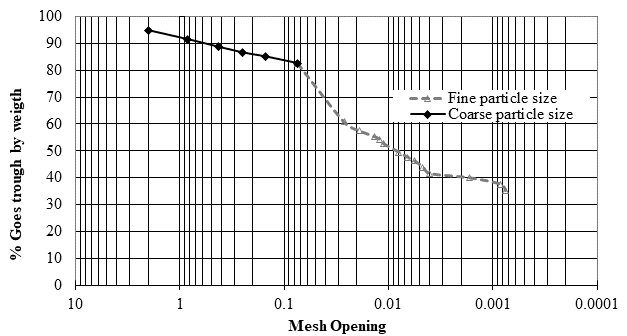
Figure 5.
Particle size analysis combining coarse and fine soils of the original simple
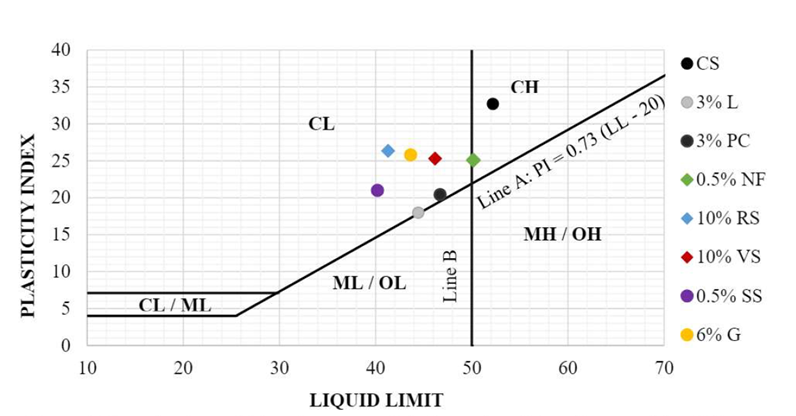
Figure 6.
Plasticity chart with location of the original sample and the mixtures with stabilizers.
Table 5. Index properties of the original soil and the mixtures with different stabilizers.
Material
w (%)
LL (%)
PL (%)
PI (%)
LC (%)
VC (%)
CS
51.15
52.20
19.51
32.69
12.93
42.27
3 % L
44.28
44.44
26.47
17.97
12.05
43.52
3% PC
46.67
46.71
26.29
20.42
12.33
45.46
0.5% NF
49.38
50.17
25.08
25.09
14.86
54.90
10 % RS
41.10
41.30
14.96
26.34
12.31
41.71
10% VS
46.06
46.19
20.89
25.34
10.04
42.98
0.5% SS
40.71
40.20
19.20
20.99
11.02
40.27
6% G
44.44
43.64
17.84
25.80
12.26
44.72
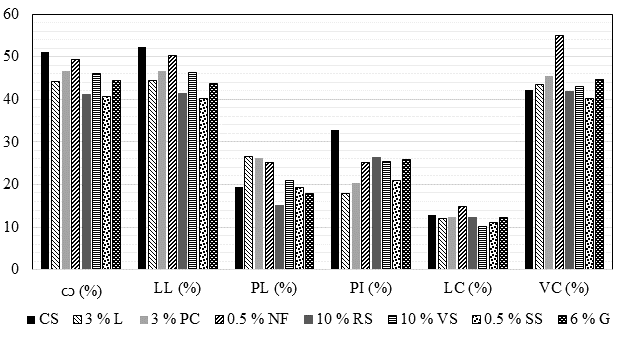
Figure 7.
Index properties of the natural soil and the stabilized mixtures.
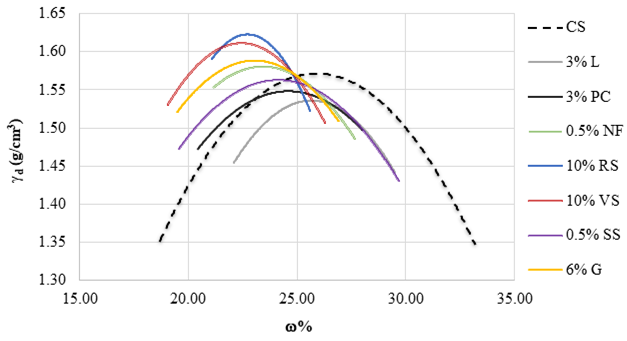
Figure 8.
Results of the Standard Proctor test (variant A).
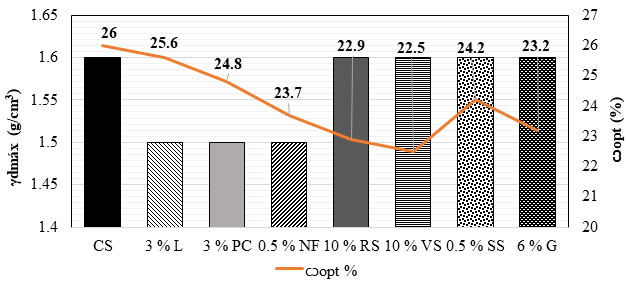
Figure 9.
Results of the Standard Proctor test (Variant A) regarding the optimum water content.
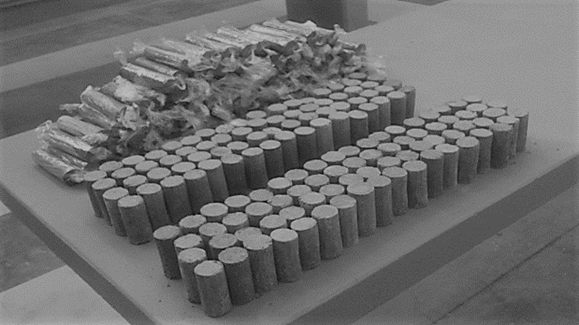
Figure 10.
144 specimens of clay mixtures with different stabilizers ready for the triaxial test UU (Miranda, 2017).
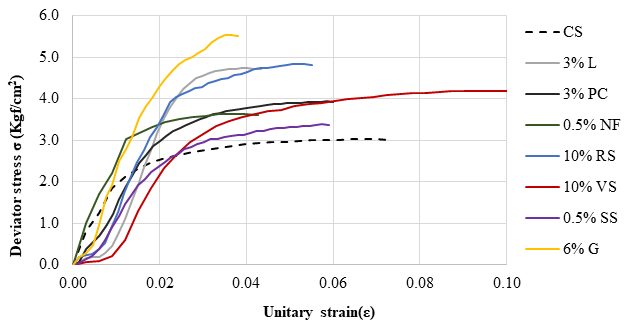
Figure 11.
Stress-strain diagram curves.
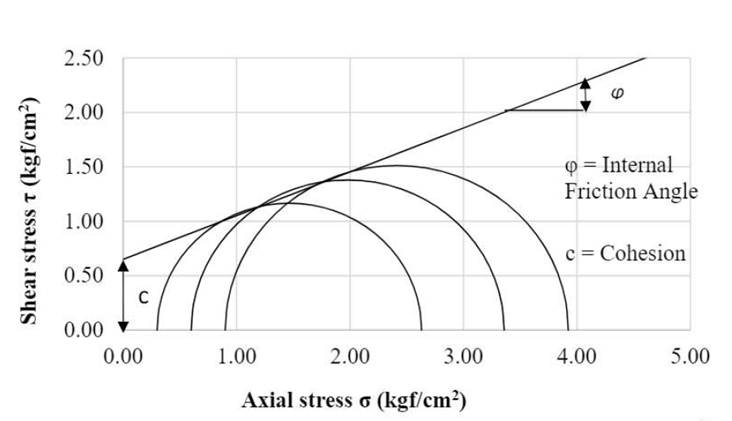
Figure 12.
Rupture envelope obtained for the original soil (in situ), c = 0.65 kgf/cm2 y ( = 22°.
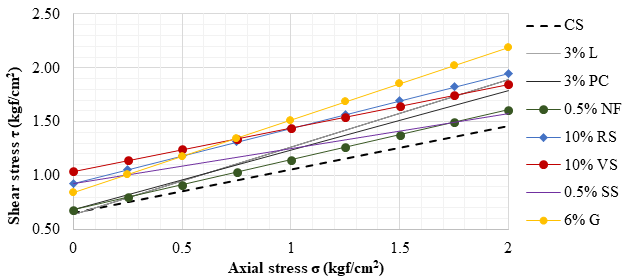
Figure 13.
Correlative of the rupture envelopes of the control sample and the mixtures with stabilizers.
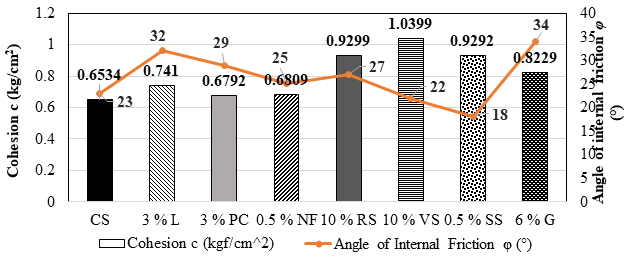
Figure 14.
Cohesion (c) and internal friction angle (() values of the original sample and the mixtures with stabilizers.
